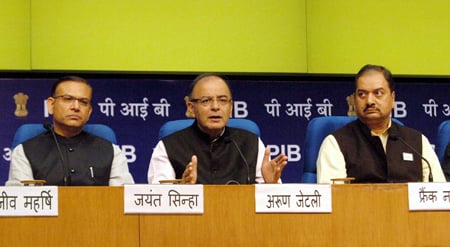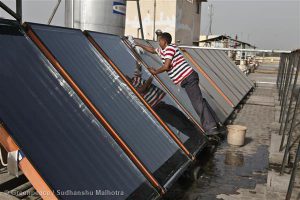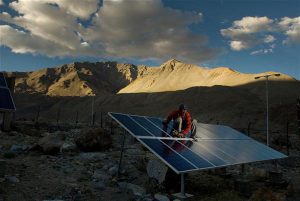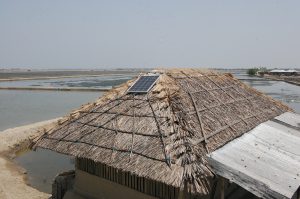India took an important step on Saturday to finance its ambitious plan to generate 100 gigawatts of solar power by 2022, by doubling the tax on coal. Presenting the country’s annual budget, Finance Minister Arun Jaitley announced that the tax would now be Rs 200 ($3.25) for every metric tonne of coal mined, double the Rs 100 per metric tonne he had announced last July. That in turn, had been double the tax imposed by the previous government in 2010.
The coal tax goes to a National Clean Energy Fund (NCEF), which has already mopped up around Rs 17,000 crore ($2.76 billion). By September last year, 46 clean energy projects worth Rs.16,511.43 crore ($2.7 billion) were recommended for funding out of the NCEF, but disbursement has been slow.
Still, the redoubling of the tax was welcomed by environmentalists. Chandra Bhushan Singh, Deputy Director of the New Delhi-based think tank Centre for Science and Environment (CSE), told thethirdpole.net, “Increasing the coal tax is a very good move provided the money is used for the specific purpose. While presenting the budget and the annual economic survey (the previous day), the finance minister talked about coal and health. It will be a good idea to use the amount generated from the tax to clean existing coal-fired power plants. In the past, utilisation of the fund has been poor. So the money will be well spent if it is used to clean up the existing coal-based thermal energy sector which is responsible for nearly 50% of the industrial pollution load in the country.”
Karthik Ganesan of another New Delhi-based think tank, Council on Energy, Environment and Water (CEEW), told thethirdpole.net, “Doubling the clean energy cess [tax] is a fantastic move. It certainly won’t hurt the coal industry. But the funds must find their way back for the original purpose of providing clean energy. It shouldn’t be used for other purposes like cleaning up toxic sites or old mines. It should go into research and setting up of renewable energy infrastructure.”
The annual economic survey has claimed that India has effectively placed a tax on carbon emissions by increasing taxes on petrol and diesel. It has calculated that these measures will lead to a reduction of 11 million tonnes of carbon dioxide emissions in less than a year compared to the baseline. That would represent 0.6% of India’s annual greenhouse gas (GHG) emissions.
GHG emissions are causing climate change, and in this year of the Paris climate accord, India is under pressure to mitigate its emissions – since it is now the world’s third largest emitter after China and the US. The economic survey, however, pointed out that the extra GHG in the atmosphere that is causing climate change has been accumulating since the start of the Industrial Age, and India’s contribution to this total between 1850 and 2011 was 3%, compared to 21% by the US and 18% by the European Union.
Still, the economic survey has highlighted some steps taken and planned by India to combat climate change. By the end of last year, the country’s installed renewable power capacity reached 33.8 GW – of this, 66% is wind energy, followed by biomass, small hydro and solar.
The survey also says scaling up the solar plan to generate 100 GW by 2022 is “likely to generate business opportunities of the order of $160 billion… Some of India’s major immediate plans on renewable energy include scaling up cumulative installed capacity to 170 GW and establishing a National University for Renewable Energy.”
Ganesan of CEEW pointed out, “The renewable energy targets have been doing the rounds but the budget didn’t present any clarity on the investments needed to achieve the targets. For instance, there is no clarity on the finance needed for manufacturing and research in the renewable sector. Nothing has been done in the last three years that shows India is ready for the targets. The budget also didn’t bring back the benefit of accelerated depreciation for the wind industry which is needed to boost wind power in the country. We need power reforms first.”
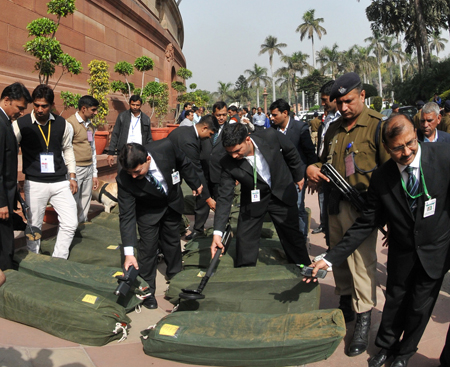
No money to check air pollution
With air pollution in Indian cities, especially New Delhi, being in the news in recent weeks, environmentalists had been hoping for some concrete steps in the budget to tackle the menace. But they were disappointed by the silence of the finance minister on the issue, except to announce an outlay of Rs 75 crore ($12 million) to encourage electric vehicles.
Singh of CSE said, “Despite the fact that the finance minister has talked about how pollution affects the poor and the biggest impacts are due to air pollution, there is nothing in the budget that will help improve the quality of air other than electric vehicles, which is only going to come in future. There is nothing on how to reduce pollution, how to improve air quality and the health of poor. The budget doesn’t even talk about investing in public transport.”
Ganesan of CEEW said, “The outlay for electric cars is just a token amount. It is nothing compared to the scale of investment that is needed to roll out electric vehicles in a big way. It shows the government’s intent is in the right direction but it is not an aggressive measure.”
Some money to clean the Ganga
Finance Minister Jaitley did announce an outlay of Rs 4,173 crore ($677 million) for the government’s flagship scheme to clean the river Ganga and for other measures to be taken by the ministry of water resources.
Himanshu Thakkar of the NGO South Asia Network for Dams, Rivers and People told thethirdpole.net, “It seems they have reduced the amount for river Ganga. Last year they announced Rs 4,200 crores for Ganga alone, but this time it is 4,173 crores which will be divided between the Ministry of Water Resources and Namami Ganga (as the programme to clean the river is called). There is no clarity on where this money will be spent. They have not yet taken a single inspiring move that gives confidence that the river will be cleaned. Their initiatives have mainly included more barrages, river front development, hydropower projects, emphasis on river-linking, which are all detrimental to the river.”
Singh of CSE said, “They have set aside some finance for Ganga and extended tax exemptions for donations. But tackling massive environmental challenges like air and water pollution requires massive infrastructure. When the finance minister talked about infrastructure, he meant airports, roads, container terminals etc., but he didn’t address the massive environmental infrastructure deficit. To clean up the river, we need sewage treatment plants, industrial effluent treatment plants. But there was no mention of that.”
